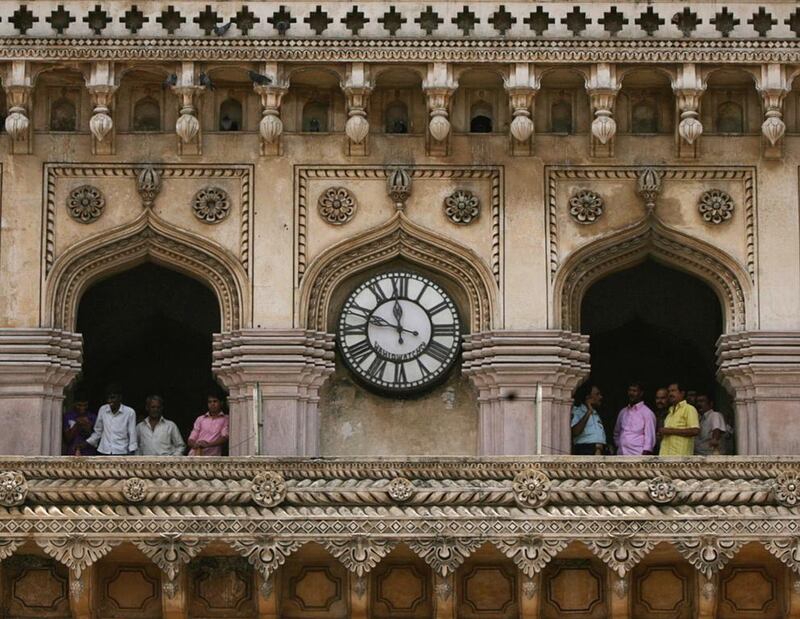NEW DELHI // At first glance, Room 35 on the ground floor of Delhi’s national physical laboratory (NPL) appears unremarkable.
It is small and ferociously air-conditioned. The only thing in the room is a bank of monitors displaying red numbers, locked away behind a glass partition.
However, it is this seemingly run-of-the-mill equipment that makes the room unique.
The monitors show the time from five caesium clocks, each roughly the size of a computer processor. Together, they set the official Indian Standard Time (IST) — in a sense making Room 35 the fount of all time in India.
Even as the laboratory is finding new ways to measure time with greater precision, critics continue to call for a revision of IST.
India has had a standardised time zone — five-and-a-half hours ahead of Greenwich Mean Time — for more than a century.
But the country is too large for a single time-zone, critics point out. A smarter standard time could save millions of units of electricity and alleviate the problems in India’s north-eastern states, which often find themselves plunged into mid-evening darkness.
States in the north-east — Assam, in particular — have long pressed for a second time zone to be officially created for the region. Since India’s time meridian passes through Mirzapur in Uttar Pradesh — roughly halfway between the country’s westernmost and easternmost points — the eastern states experience nightfall as early as 4.30pm in the winter months.
In 2006, India’s federal planning commission recommended the division of the country into two time zones, but no action was taken. Then last year, the Assam state government unilaterally set its clocks an hour ahead of the rest of India.
“IST has affected our productivity, besides forcing us to follow a schedule not suited to the time zone we are in,” Tarun Gogoi, Assam’s chief minister, said at the time.
As an institution, the laboratory doesn’t offer any views on this debate. When NPL was established in 1947, one of its mandates was to officially set the basic units of time, weight, distance and other measurements.
When it first started maintaining IST, the laboratory did so with the help of a quartz oscillator, recalls Ashish Agarwal, a senior scientist in NPL’s time and frequency standards division. But in the late 1960s, NPL — like laboratories around the world — adopted caesium clocks, marking out individual seconds based on the frequencies of electrons in the caesium atom.
“The quartz oscillator could lose or gain a few seconds every few months or few years,” Mr Agarwal said. “With the caesium clock, we might lose or gain a second every few thousand years.”
Computers sync NPL’s clocks with those at the international bureau of weights and measures in Paris. Other computers pipe official IST to India’s stock exchanges, railways, mobile telecommunication companies, and the space research organisation, among other bodies.
“People often say as a joke that following Indian Standard Time means being delayed,” Mr Agarwal said with a laugh, referring to the stereotype of people in India always running late.
“But we maintain a very precise time.”
In fact, the measurement of time in India is poised to get more accurate still.
In another section of Room 35, behind a locked door, is a large apparatus known as a caesium fountain clock. It consists of a tall, cylindrical metallic drum and a glass-topped case of electronics the size of a foosball table.
The laboratory has been indigenously developing the fountain clock for several years now, Mr Agarwal said, trying to master the technology of cooling caesium atoms to a temperature very close to absolute zero (minus 273ºC).
“We are one of only seven or eight places in the world to have developed this technology,” Mr Agarwal said, adding that the clock is currently being tested.
Once it is operational, “it will be a clock that only gains or loses a second in a few million years”.
But what is really required is a rethinking of IST altogether, said DP Sen Gupta, a professor at the National Institute of Advanced Studies in Bengaluru.
In 2007, Mr Sen Gupta and a colleague published a paper calling for IST to be advanced by half an hour. The move, the paper calculated, would save 2.7 billion units of electricity every year — enough to power the city of Delhi for 110 days.
Another option — following Daylight Savings Time concept in the United States — didn’t result in energy savings that were as significant. The third option of dividing India into two time zones was likely to meet political resistance, Mr Sen Gupta said.
“It may not be a wise decision,” he said. “Even if notionally you have eastern and western time zones, there may be political parties or agencies that will capitalise on this and ultimately want a West India and East India division.”
Once India moves its clocks forward half an hour, Mr Sen Gupta said, “It’ll get into our system. It will just be a new Indian Standard Time.”
ssubramanian@thenational.ae





